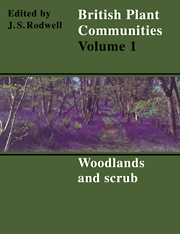Book contents
- Frontmatter
- Contents
- List of Figures
- Foreword
- Preface and Acknowledgements
- Preamble
- General Introduction
- Woodlands and Scrub
- Introduction to Woodlands and Scrub
- Key To Woodlands and Scrub
- Community Descriptions
- W1 Salix Cinerea-Galium Palustre woodland
- W2 Salix Cinerea-Betula Pubescens-Phragmites Australis Woodland
- W3 Salix Pentandra-Carex Rostrata Woodland
- W4 Betula Pubescens-Molinia Caerulea Woodland
- W5 Alnus Glutinosa-Carex Paniculata Woodland
- W6 Alnus Glutinosa-Urtica Jzozca Woodland
- W7 Ainus Glutinosa-Fraxinus Excelsior-Lysimachia Nemorum Woodland
- W8 Fraxinus Excelsior-Acer Campestre-Mercurialis Perennis Woodland
- W9 Fraxinus Excelsior-Sorbus Aucuparia-Mercurialis Perennis Woodland
- W10 Quereus Robur-Pteridium Aquilinum-Rubus Fruticosus Woodland
- W11 Quereus Petraea-Betula Pubescens-Oxalis Acetosella Woodland
- W12 Fagus Sylvatica-Mercurialis Perennis Woodland
- W13 Taxus Baccata Woodland
- W14 Fagus Sylvatica-Rubus Fruticosus Woodland
- W15 Fagus Sylvatica-Deschampsia Flexuosa Woodland
- W16 Quereus spp.-Betula spp.-Deschampsia Flexuosa Woodland
- W17 Quereus Petraea-Betula Pubescens-Dicranum Majus Woodland
- W18 Pinus Sylvestris-Hylocomium Splendens Woodland
- W19 Juniperus Communis Ssp. Communis-Oxalis Acetosella Woodland
- W20 Salix Lapponum-Luzula Sylvatica Scrub
- W21 Crataegus monogyna-Hedera helix scrub
- W22 Prunus Spinosa-Rubus Fruticosus Scrub
- W23 Ulex Europaeus-Rubus Fruticosus Scrub
- W24 Rubus Fruticosus-Holcus Lanatus Underscrub
- W25 Pteridium Aquilinum-Rubus Fruticosus Underscrub
- Index of Synonyms to Woodlands and Scrub
- Index of Species in Woodlands and Scrub
- Bibliography
Key To Woodlands and Scrub
Published online by Cambridge University Press: 04 July 2020
- Frontmatter
- Contents
- List of Figures
- Foreword
- Preface and Acknowledgements
- Preamble
- General Introduction
- Woodlands and Scrub
- Introduction to Woodlands and Scrub
- Key To Woodlands and Scrub
- Community Descriptions
- W1 Salix Cinerea-Galium Palustre woodland
- W2 Salix Cinerea-Betula Pubescens-Phragmites Australis Woodland
- W3 Salix Pentandra-Carex Rostrata Woodland
- W4 Betula Pubescens-Molinia Caerulea Woodland
- W5 Alnus Glutinosa-Carex Paniculata Woodland
- W6 Alnus Glutinosa-Urtica Jzozca Woodland
- W7 Ainus Glutinosa-Fraxinus Excelsior-Lysimachia Nemorum Woodland
- W8 Fraxinus Excelsior-Acer Campestre-Mercurialis Perennis Woodland
- W9 Fraxinus Excelsior-Sorbus Aucuparia-Mercurialis Perennis Woodland
- W10 Quereus Robur-Pteridium Aquilinum-Rubus Fruticosus Woodland
- W11 Quereus Petraea-Betula Pubescens-Oxalis Acetosella Woodland
- W12 Fagus Sylvatica-Mercurialis Perennis Woodland
- W13 Taxus Baccata Woodland
- W14 Fagus Sylvatica-Rubus Fruticosus Woodland
- W15 Fagus Sylvatica-Deschampsia Flexuosa Woodland
- W16 Quereus spp.-Betula spp.-Deschampsia Flexuosa Woodland
- W17 Quereus Petraea-Betula Pubescens-Dicranum Majus Woodland
- W18 Pinus Sylvestris-Hylocomium Splendens Woodland
- W19 Juniperus Communis Ssp. Communis-Oxalis Acetosella Woodland
- W20 Salix Lapponum-Luzula Sylvatica Scrub
- W21 Crataegus monogyna-Hedera helix scrub
- W22 Prunus Spinosa-Rubus Fruticosus Scrub
- W23 Ulex Europaeus-Rubus Fruticosus Scrub
- W24 Rubus Fruticosus-Holcus Lanatus Underscrub
- W25 Pteridium Aquilinum-Rubus Fruticosus Underscrub
- Index of Synonyms to Woodlands and Scrub
- Index of Species in Woodlands and Scrub
- Bibliography
Summary
With something as complex and variable as vegetation, no key can pretend to offer an infallible short cut to diagnosis. The following should therefore be seen as simply a crude guide to identifying the types of woodland and scrub in the scheme and must always be used in conjunction with the data tables and community descriptions. It relies on floristic (and, to a lesser extent, physiognomic) features of the vegetation and demands a knowledge of the British vascular flora and, at certain points, of some bryophytes. It does not make primary use of any habitat features, though these can provide a valuable confirmation of a diagnosis.
Because the major distinctions between the vegetation types in the classification are based on inter-stand frequency, the key works best when sufficient samples of similar composition are available to construct a constancy table. It is the frequency values in this (and, to a lesser extent, the ranges of abundance) which are then subject to interrogation with the key. Most of the questions are dichotomous and notes are provided at particularly difficult points and where confusing zonations are likely to be found.
As in the construction of the scheme, samples should be of 50 x 50 m for woodland canopy and shrub layer or sparse scrub, 10 x 10 m for dense scrub canopy, with either 4 x 4 m or 10 x 10 m for the field and ground layer.
1 Low scrub dominated by Salix lapponum, sometimes with S. lanata, S. myrsinites or 5. reticulata, with luxuriant mixtures of Vaccinium myrtillus, V. vitis-idaea and Empetrum nigrum ssp. hermaphroditum, Luzula sylvatica, Deschampsia cespitosa, tall dicotyledons and bryophytes; a rare community of montane crags and ledges
W20 Salix lapponum-Luzula sylvatica scrub
Scrub or underscrub with one or more of Crataegus monogyna, Prunus spinosa, Sambucus nigra, Ulex europaeus, Cytisus scoparius, Rosa canina agg. and Rubus fruticosus agg. frequent and often abundant; saplings of taller trees sometimes numerous but never forming an overtopping canopy 57
High forest or coppice in which Crataegus monogyna, Prunus spinosa, Sambucus nigra, Rosa canina agg. and Rubus fruticosus agg.
- Type
- Chapter
- Information
- British Plant Communities , pp. 35 - 46Publisher: Cambridge University PressPrint publication year: 1991

